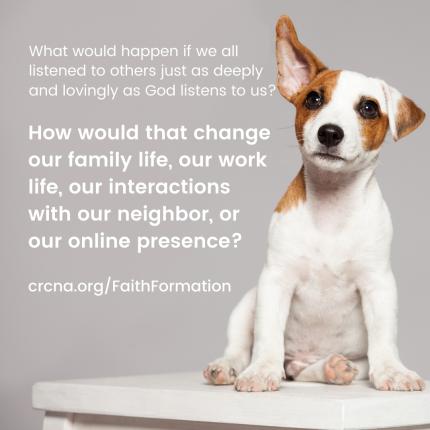As a faith practice, listening involves training ourselves to recognize God’s voice (John 10:1-6) in the midst of all the other voices calling for our attention. It involves learning to be fully present in the moment, setting aside distractions that keep us from attending to and responding to God’s presence around us.
Build-Your-Own Worship Service (or Series) on Listening
Sermon Supports
- Foundational Essay: Training Ourselves to Listen Well
- Bible passages
-
Isaiah 55:3, 10-11—Listening to God
-
Psalm 116:1-2 (ESV)—God listens to you
-
James 1:19—Listening to others
-
Psalm 19:1-4—Listening to God’s creation
-
- Recommended Resources from the Faith Practices Project
Music Suggestions
(We’ve indicated the songs from our hymnal Lift Up Your Hearts with “LUYH.”)
- “Ancient Words” by Lynn DeShazo (LUYH)
- “Be Still and Know” (LUYH)
- “Come and Listen” by David Crowder
- “Full Attention” by Jeremy Riddle
- “Here I Am, Lord” by Daniel Schutte (LUYH)
- “Jesus Saves” by Priscilla Owens
- “Let Children Hear the Mighty Deeds” by Isaac Watts (LUYH)
- “Listen, God Is Calling” by Howard S. Olson (LUYH)
- “Lord, Listen to Your Children Praying” by Ken Medema (LUYH)
- “Lord, Speak to Me that I May Speak” by Francis Havergal (LUYH)
- “New Wine” by Hillsong
- “Not What My Hands Have Done” by Horatius Bonar (LUYH)
- “Open Our Eyes, Lord” by Robert Cull (consider using this and incorporating motions/body movement for the different verses) (LUYH)
- “Show Us Christ” by Sovereign Grace
- “Speak, O Lord” by Keith Getty and Stuart Townend (LUYH)
Worship Ideas
Below you’ll find ideas that can be modified and woven into a worship service as a way for people to experience this practice.
- Go outside. If possible, begin your service outdoors and notice how God speaks through creation. Listen together. What do you hear? How does God speak through what you are seeing? Read a psalm of creation (Psalm 8; 19; etc.) and sing a creation song before going indoors.
- Consider what’s in the way. What makes it difficult to listen and hear God’s voice? Consider doing something interactive around this question. For example, invite people to respond by writing their answer, drawing a picture, or cutting out a related photo from a magazine. What prevents us from hearing God clearly? Talk through what you see together and then pray together, asking that you may hear God’s voice in new ways.
- Build a litany. As a group, write a responsive litany that you can use in worship in the future. Use something consistent with accessible language so that all ages can participate. The congregational line could be “We are listening, God” or “Thank you for speaking to us.” If it’s a consistent response, you could rewrite the leader part whenever you use the litany and adapt to your service theme/season. If you use it often and keep the language uniform, all ages will recognize it and be able to participate in future worship services.
- Tell a story. The Rabbit Listened by Cori Doerrfeld offers a wonderful jumping-off point for a conversation about listening well—to God and with others.
- Hear a story. Invite someone to share a story of how they’ve experienced listening for and hearing God’s voice in their life. Ask someone to share a story of how they practice listening, what they’ve found to be a helpful way to remove distractions, etc. You might end this time by providing space for people to ponder the question on this slide: Listening for God’s voice.
- Practice preparing to listen. Teach people a simple way to prepare for listening: “Place your hands on your lap or on your heart as together we take a deep breath in . . . and out . . . In . . . and out.” This could be done prior to silent prayer, before a piece of music is played or a song is sung, prior to reading Scripture, or before gazing at some artwork or photographs.
- Be still. In a culture that values busyness, learning to make space for stillness can be challenging. Help people practice silence in daily life by making space for it during worship. You might intentionally include a moment of silence during a congregational prayer, prior to or following music, before or after the offering, or as part of a message. Invite people to simply “be still” and soak in the assurance that God is God.
Take-it-Home Resources
Encourage and equip people to continue exploring this faith practice by providing them with a resource to take home. Some ideas:
- A list of Story Starters to use as a way to practice listening well.
- A simple opaque container (even a large plastic envelope will do!) marked “Tech Sabbath” to encourage intentionally disconnecting from technology and making space to listen to God. You might add a note suggesting that people try using it for one hour each day, for one day each week, or for one week each year.
- 5 Ways to Practice Listening with your Family for each household with children.
- The booklet Faith Practices: Holy Habits That Help Us Love God and Our Neighbor, Listen to the Spirit, and Become More Like Jesus.
Digital Images You Can Use
Use these memes for PowerPoint presentations, social media shares, print pieces, and so on.





